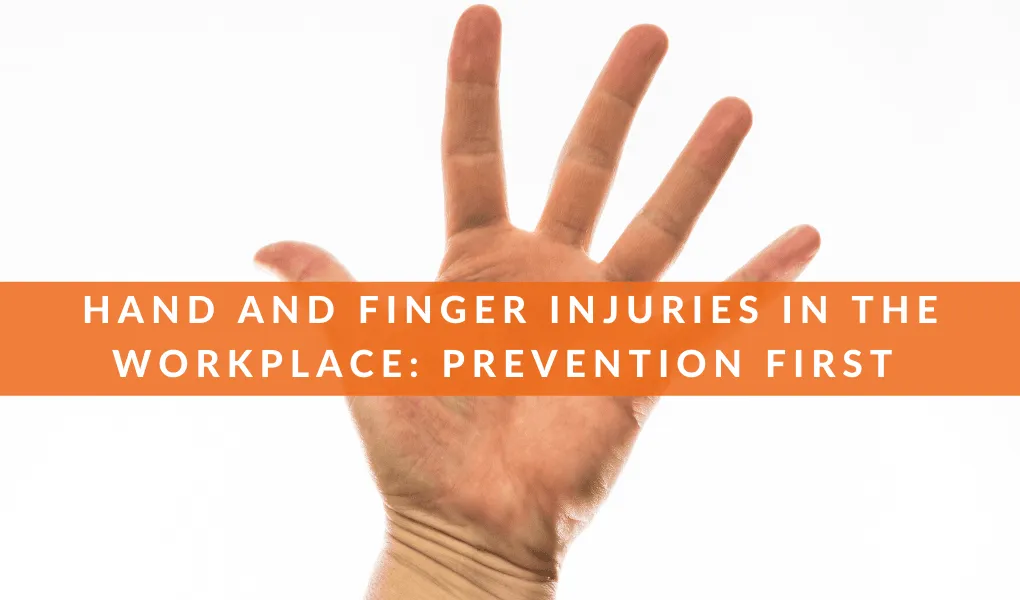Hand Injury Prevention: 5 Ways to Keep Hands Safe at Work

Hand injury prevention techniques are essential in high-risk workplaces. It’s paramount that your workers take extra care of their bodies when working with dangerous tools. According to a 2012 hand injury prevention training PPT by Telcom Insurance Group, 75 percent of U.S. industrial injuries that cause partial disability involve hands. In addition, over 16 million Americans seek medical care for hand injuries annually. Not only that, but every 32 seconds there’s a hand injury at work. Those are worrying statistics.
There are a myriad of ways to protect hands in the workplace. Let’s take a look at five hand injury prevention tips to put into practice.
1.Wear Personal Protective Equipment (PPE)
Wearing gloves is non-negotiable when it comes to hand safety. Most hand injuries are preventable with the correct gloves. Some gloves prevent impact injuries, others are for laceration protection, while still others work to guard against chemical burns. Know your gloves and the level of protection they offer. Provide your staff with the types of gloves they need.
Gloves must fit well. A common complaint from workers is that gloves are uncomfortable and impair dexterity. Ill-fitting gloves can cause more risks than they prevent. Make sure gloves fit well and don’t inhibit movement. And gloves, like all equipment, must always be in good working order.
Beyond that, enact a no-tolerance policy around not wearing personal protective equipment (PPE). This is an easy precaution to follow, and there are no excuses for dismissing it.
2. Use Safe, Well-Maintained Equipment and Tools
Making sure your workers have the safest equipment and that it is always in good working order will greatly reduce risks of injury. Never allow workers to use tools that are altered or jury-rigged. Any equipment that isn’t working perfectly must be put out of commission until it’s fixed. And workers must always use safety guards when possible.
Set up a maintenance schedule for equipment and tools. And periodically check to see if there are safer options for the tools and equipment your employees are currently using. For instance, do your workers have the best safety knife available? Keep up to date on innovations in design and materials to ensure that your workers have access to the safest items on the market.
3. Stretch, Strengthen, and Go Ergo
Many workers are tasked with doing the same types of movements repeatedly, and overuse-strain injuries are common in the workplace. To prevent these types of injuries, workers must be certain not to overtax their hands, wrists, and forearms day in and day out. Staff will benefit from stretching hands, fingers, and wrists before and after work, and once or twice an hour.
Make sure your workers do movements that are the opposite of those required by whatever repeated task they’re doing. Encourage employees to do hand strengthening exercises two or three times a week to keep hands strong and able to endure long periods of work without fatiguing.
Check that tools and equipment are well designed. Items that are ergonomically designed allow for comfortable, natural movements; they’re made to feel like an extension of the body. This greatly helps reduce fatigue and muscle strain.
4. Be Aware
Awareness is a key component in workplace safety in general. Workers should be mindful of the actual and potential hazards around them. This means no screen time, headphones, or phone calls while performing work.
In addition, workers always need to be aware of what they’re touching and where their hands are going. They should never put their hands where they can’t be seen.
Awareness should extend to watching for trip-and-fall hazards: When people fall, the first action they usually take to protect themselves is to put out their hands to catch themselves. Always being aware of where you’re going and the surfaces you’re coming into contact with will help keep your hands safe.
5. Take Your Time, Be Prepared
Before embarking on any task, your workers need to be sure the area is safe and clear, and that they’re following all precautions and protocols. They should stop and take a beat. Check the area for clutter that may cause a distraction or get in the way. Are gloves on and do they fit well? Is all equipment in good shape? Is anyone in the way?
Taking a minute or two to double check that your crew is following all safety procedures — not cutting corners or taking anything for granted — is a great way to refocus attention on staying safe. Think of it as a version of the carpenter’s rule: “Measure twice, cut once.”
Small Efforts Reap Big Benefits
Keeping hands healthy and injury free is simple. It requires consistent attention to protocols, but consider the great payoff: Your workers maintain healthy hands and avoid painful, frustrating injuries. The company saves money and benefits from a happier, more effective workforce.
